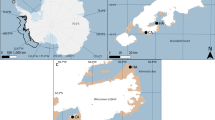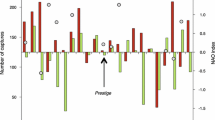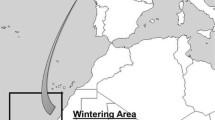Abstract
Demographic parameters were estimated for snow petrels Pagodroma nivea nesting at Pointe Géologie Archipelago, Adélie Land, Antarctica between 1963 and 1990; 21 years of data on adult survival and 27 years of data on breeding success are available. The average age of first return and first breeding were 8.1 and 9.9 years respectively and there was no signifcant difference between the sexes. The overall breeding success averaged 51.3% and was very variable between years (21–80%). Breeding failure was mostly due to incubation failure and annual breeding success was negatively correlated with average snow falls in October–November and October–March. Breeding frequency was very low, averaging 52% of seasons during a reproductive lifetime. Good quality sites, with high occupancy rate and high breeding success were few in the study plots. Poor years in 1966–1967, 1976–1977 and 1983–1984, with low breeding success, very low proportions of nets with breeding attempts and high numbers of non-breeders, occurred 1 year after large-scale El Niño Southern Oscillation (ENSO) events. Snow petrels exhibited very low philopatry. Only 45 birds have been recovered in the study plots from a total of 1115 banded fledglings giving an estimated rate of return of 12.9% between fledging and 3 years old. Annual survival between 3 and 10 years was 91.4%. Annual adult survival (93.4%), though variable, was low during poor years of 1977–1978 and 1983–1984. Adult survival of males (94.7%) was not significantly different from that of females (93.9%). Over the study period, the population of Pointe Géologie was stable. Using the estimated parameters, a Leslie model gave a growth rate of 0.948%, which was probably compensated by immigration (5.7% per year). Restricted numbers of good-quality sites at the place of birth could have led young birds to prospect other colonies and could have selected low philopatry. High adult survival, strong site tenacity and capacity to spread breeding over a long lifetime are probably part of the adaptive strategy of this small fulmarine petrel facing highly variable environmental conditions.
Similar content being viewed by others
References
Ainley DG, Boekelheide RJ (1990) Seabirds of the Farallon Islands. Stanford University Press, Stanford
Ainley DG, Leresche RE, Sladen WJL (1983) Breeding biology of the Adélie Penguin. University of California Press, Berkeley
Ainley DG, O'Connor EG, Boekelheide RJ (1984) The marine ecology of birds in the Ross Sea, Antarctica (Monography. No 32). American Ornithologists' Union, Washington, D.C.
Ainley DG, Fraser WR, Sullivan CW, Jones JJ, Hopkins TL, Smith WO (1986) Antarctic mesopelagic micronecton: evidence from seabirds that pack-ice affects community structure. Science 232: 847–849
Ainley DG, Carter HR, Anderson DW, Briggs KT, Coulter MC, Cruz F, Cruz JB, Valle CA, Fefer SI, Hatch SA, Schreiber EA, Schreiber RW, Smith NG (1988) Effects of the 1982–83 El Nino Southern Oscillation on Pacific bird populations. In: Ouellet H (eds) Acta XIX Congressus Internationalis Ornithologici. Ottawa University Press, Ottawa, pp 1747–1758
Beck JR, Brown DW (1972) The breeding biology of Wilson's storm petrel, Oceanites oceanicus (Kuhl), at Signy Island, South Orkney Islands. Br Antarct Surv Sci Rep 69:1–54
Bradley JS, Wooller RD, Skira IJ, Serventy DI (1989) Age dependent survival of breeding short-tailed shearwaters Puffinus tenuirostris. J Anim Ecol 58:175–188
Brown DA (1966) Breeding biology of the Snow Petrel. ANARE Sci Rep 89:1–63
Clobert J, Lebreton JD, Clobert-Gillet M, Coquillard H (1985) The estimation, of survival in birds populations by recaptures or sightings of marked individuals. In: Morgan BJT, North PM (eds) Statistics in ornithology (Lecture notes in statistics, vol 29), Springer, New York, pp 197–213
Coulson JC (1968) Differences in the quality of birds nesting in the centre and on the edges of a colony. Nature 217:478–479
Cormack RM (1964) Estimates of survival from the sighting of marked animals. Biometrika 51: 429–438
Crawford RJM, Shelton PA (1978) Pelagic fish and seabird interrelation-ships off the coasts of South West and South Africa. Biol Conserv 14:85–109
Croxall JP (1984) Seabirds. In: Laws RM (eds) Antarctic Ecology, vol 2, pp 533–619
Croxall JP, Maccann TS, Prince PA, Rothery P (1988) Reproductive performance of seabirds and seals at South Georgia and Signy Islands, 1976–1987: implications for southern ocean monitoring studies. In: Sahrase D (eds) Antarctic Ocean and resources variability. Springer, Berlin Heidelberg New York, pp 265–285
Duffy DC (1983) Competition for nesting space among Peruvian guano birds. Auk 100:680–688
Duffy DC, Arntz WE, Serpa HT, Boersma PD, Norton RL (1988) A comparison of the effects of El Nino and Southern Oscillation on birds in Peru and the Atlantic Ocean. In: Ouellet H (eds): Acta XIX Congressus Internationalis Ornithologici, Ottawa University Press, Ottawa, pp 1740–1746
Dunnet GM, Ollason JC (1978) The estimation of survival rate in the fulmar Fulmarus glacialis. J Anim Ecol 47:507–520
Dunnet GM, Ollason JC, Anderson A (1979) A 28 year study of breeding fulmars Fulmarus glacialis. Ibis 121:293–300
Guillotin M, Jouventin P (1980) Le pétrel des neiges à Pointe Géologie. Le Gerfaut 70:51–72
Hudson R (1966) Adult survival estimates for two Antarctic Petrels. Br Antarc Surv Bull 8:63–73
Isenmann P (1970) Contribution à la biologie de reproduction du pétrel des neiges: le problème de la petite et de la grande forme. L'Oiseau et la RFO 40:99–134
Jouventin P, Viot CR (1985) Morphological and genetic variability in the snow petrels. Ibis 127:430–441
Joventin P, Weimerskirch H (1990) Long-term changes in seabird and seal populations in the southern ocean. In: Kerry KR, Hempel G (eds) Antarctic ecosystem, Ecological change and conservation. Springer, Berlin Heidelberg New York, pp 208–213
Jouventin P, Weimerskirch H (1991) Changes in the population size and demography of southern seabirds: management implications. In: Perrins CM, Lebreton JD, Hirons GJM(eds) Bird population studies, relevance to conservation and management (Oxford Ornithology Series) Oxford, University Press, pp 297–314
Lack D (1968) Ecological adaptations for breeding in birds. Methuen, London
Leslie PH (1945) The use of matrices in certain population mathematics. Biometrika 33:183–212
Leslie PH (1948) Some further notes on the use of matrices in population mathematics. Biometrika 35:213–245
Lloyd C, Tasker M, Partridge K (1991) The status of seabirds in Britain and Ireland. Poyser Carlton, London
Mougin JL (1968) Etude écologique de quatre espèces de pétrels antarctiques L'Oiseau et la RFO 38:1–52
Mougin JL (1975) Ecologie comparée des Procellariidés antarctiques et subantarctiques. CNFRA 36:1–195
Newton I (1989) Life time reproduction in birds. Academic, London
Perrins CM, Harris MP, Britton CK (1973) Survival of Manx shearwaters Puffinus puffinus. Ibis 115:535–548
Porter JM, Coulson JC (1987) Long-term changes in recruitement to the breeding group and the quality of recruits at a kittiwake Rissa tridactyla colony. J Anim Ecol 49:675–689
Potts GR, Coulson JC, Dean IR (1980) Population dynamics and the breeding success of the shag Phalacrocorax aristotelis on the Farne Islands, Northumberland. J Anim Ecol 49: 465–484
Pradel R (1989) User's manual for program SURGE4. CEPE, Montpellier
Ridoux V, Offredo C (1989) The diets of five summer breeding seabirds in Adélie Land, Antarctica. Polar Biol 9:137–145
Ryan PG, Avery G, Rose B, Ross GJB, Sinclair JC, Vernon CJ (1989) The southern ocean seabird irruption to south African waters during winter 1984. Cormorant 17:41–55
Thomas T (1986) L'effectif des oiseaux nicheurs de l'archipel de Pointe Géologie (Terre Adélie) et son évolution au cours des trente dernières années. L'oiseau et la RFO 56:349–368
Trivelpiece WZ, Trivelpiece SG, Geupel GR, Kjelmyr J, Volkman NJ (1990) Adélie and chinstrap penguins: their potential as monitors of the southern ocean marine ecosystem. In: Kerry KR, Hempel G (eds) Antarctic ecosystem, Ecological change and conservation. Springer, Berlin Heidelberg New York, pp 191–202
Van Franeker JA, Montague T (1987) Recoveries of petrels banded near Casey Station, Wilkes Land, Antarctica, 1984 to 1985. Corella 11:37–43
Wanless S, French DD, Harris MP, Langslow DR (1982) Detection of annual changes in the numbers of cliff-nesting seabirds in Orkney 1976–1980. J Anim Ecol 51:785–795
Warham J (1990) The petrels, their ecology and breeding systems. Academic, London
Weimerskirch H, Clobert J, Jouventin P (1987) Survival in five southern albatrosses and its relations with their life history. J Anim Ecol 56:1043–1056
Whitehead MD, Johnstone GW, Burton HR (1990) Annual fluctuations in productivity and breeding success of Adélie penguins and fulmarine petrels in Prydz Bay, East Antarctica. In: Kerry KR, Hempel G (eds) Antarctic ecosystem, Ecological change and conservation. Springer, Berlin Heidelberg New York, pp 214–223
Woehler EJ, Johnstone GW (1991) Status and conservation of the seabirds of the Australian Antarctic Territories. In: Croxall JP (eds) Seabird: status and conservation, a supplement (Technical publication No. 11). International Council for Bird Preservation, Cambridge, pp 279–308
Author information
Authors and Affiliations
Rights and permissions
About this article
Cite this article
Chastel, O., Weimerskirch, H. & Jouventin, P. High annual variability in reproductive success and survival of an Antarctic seabird, the snow petrel Pagodroma nivea . Oecologia 94, 278–285 (1993). https://doi.org/10.1007/BF00341328
Received:
Accepted:
Issue Date:
DOI: https://doi.org/10.1007/BF00341328




